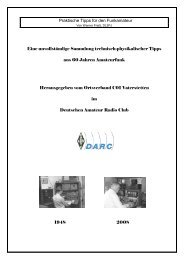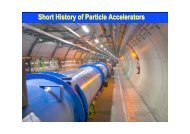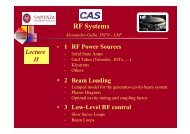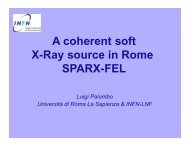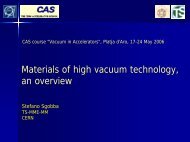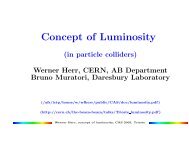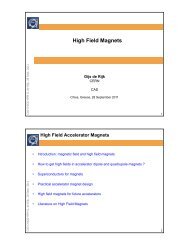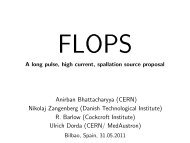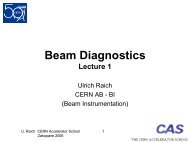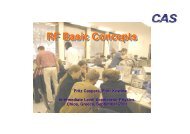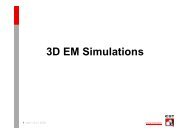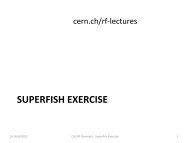Ion sources for Fusion I, II - CERN Accelerator School
Ion sources for Fusion I, II - CERN Accelerator School
Ion sources for Fusion I, II - CERN Accelerator School
Create successful ePaper yourself
Turn your PDF publications into a flip-book with our unique Google optimized e-Paper software.
<strong>Ion</strong> Sources <strong>for</strong> <strong>Fusion</strong><br />
W. Kraus<br />
Max-Planck-Institut für Plasmaphysik<br />
EURATOM Association<br />
Boltzmannstr. 2, D-85748 Garching<br />
Max-Planck-<br />
Institut<br />
für<br />
Plasmaphysik<br />
2. June 2012 <strong>CERN</strong> <strong>Accelerator</strong> <strong>School</strong> – <strong>Ion</strong> Sources Senec, Slovakia
<strong>Ion</strong> <strong>sources</strong> in fusion devices<br />
<strong>Ion</strong> <strong>sources</strong> are used in neutral beam injection systems (NBI)<br />
Neutral atoms can penetrate through the confining magnetic<br />
field.<br />
Used <strong>for</strong><br />
Neutral beam heating<br />
Current drive<br />
Diagnostics beams<br />
W. Kraus 2. June 2012 <strong>CERN</strong> <strong>Accelerator</strong> <strong>School</strong> – <strong>Ion</strong> Sources<br />
2
Outline<br />
• Plasma heating by neutral beam injection<br />
• Positive <strong>Ion</strong> <strong>sources</strong> <strong>for</strong> Neutral Beams<br />
• Negative ion based neutral beam injection<br />
• Beam extraction<br />
• Production of negative ions<br />
• Negative ion <strong>sources</strong><br />
• Experimental results with the RF prototype<br />
• Giant source <strong>for</strong> ITER<br />
• Test facilities<br />
W. Kraus 2. June 2012 <strong>CERN</strong> <strong>Accelerator</strong> <strong>School</strong> – <strong>Ion</strong> Sources<br />
3
NBI: the work horse<br />
NBI heating is dominant in most large past, present, and planned tokamaks<br />
R 0<br />
(m)<br />
a<br />
(m)<br />
I p<br />
(MA)<br />
B t<br />
(T)<br />
Installed heating power (MW)<br />
P-NBI N-NBI ECRH ICRH LH<br />
ITER 6.2 2.0 15 5.3 - 33 20 20 -<br />
JET 2.96 1.25 4.8 3.45 34* - - 10 7<br />
JT-60U 3.4 1.1 5 4.2 40 3 4 7 8<br />
JT-60SA 2.97 1.17 5 2.25 24 10 7 - -<br />
TFTR 2.4 0.8 2.2 5 40 - - 11 -<br />
EAST 1.7 0.4 1.0 3.5 - - 0.5 3 4<br />
D<strong>II</strong>I-D 1.67 0.67 2.1 20 - 5 4 -<br />
ASDEX Upgrade 1.65 0.65 1.2 3.1 20 - 6 8 -<br />
*recently upgraded<br />
W. Kraus 2. June 2012 <strong>CERN</strong> <strong>Accelerator</strong> <strong>School</strong> – <strong>Ion</strong> Sources<br />
4
Neutral beam heating: trapping and penetration<br />
Interaction of fast neutrals with the plasma<br />
• ionisation by collisions with plasma electrons<br />
and ions<br />
• drift of the fast ions in the magnetic field<br />
• collisions of the fast ions with plasma ions<br />
and electrons => slow-down and scattering<br />
• charge exchange collisions with background<br />
neutrals<br />
W. Kraus 2. June 2012 <strong>CERN</strong> <strong>Accelerator</strong> <strong>School</strong> – <strong>Ion</strong> Sources<br />
5
Penetration depth<br />
Attenuation of the beam in an uni<strong>for</strong>m Hydrogen plasma<br />
Approximation <strong>for</strong> the absorption<br />
length <strong>for</strong> ionisation<br />
n in 10 19 m -3 , A in amu, E in keV<br />
Penetration depth depends on the energy<br />
Example AUG: 100 keV D beam, n e = 5x10 19 m -3 => λ = 0.5 m<br />
Fraction not absorbed by the plasma : shine-through<br />
determines minimum plasma density<br />
W. Kraus 2. June 2012 <strong>CERN</strong> <strong>Accelerator</strong> <strong>School</strong> – <strong>Ion</strong> Sources<br />
6
Slowing down – power to the ions and electrons<br />
Change of energy of a fast ion<br />
to<br />
ions<br />
to<br />
electrons<br />
Stopping by ions and electrons is<br />
equal at the<br />
“Critical energy” E c<br />
E c depends on the electron temperature<br />
Lower energy of E 0/2 and E 0/3<br />
=> <strong>Ion</strong> heating dominates <strong>for</strong> E 0 < 100kV<br />
W. Kraus 2. June 2012 <strong>CERN</strong> <strong>Accelerator</strong> <strong>School</strong> – <strong>Ion</strong> Sources<br />
7
Neutral Beam Current Drive (NBCD)<br />
Why Current Drive (CD) ?<br />
Tokamaks: Plasma current is driven inductively (principle: trans<strong>for</strong>mer). <br />
=> pulsed operation<br />
⇒ <strong>for</strong> reactor: pulsed energy production, pulsed <strong>for</strong>ces and heat loads <br />
on components → reduced lifetime. There<strong>for</strong>e aim (e.g. on ITER)<br />
• "stationary tokamak" - completely non-inductive CD<br />
• enhanced pulse length - significant part of I p non-inductive CD<br />
Local modification of plasma current profile − j P (r) <br />
to improve plasma confinement (internal transport barriers, improved <br />
H-mode) and/or plasma stability (NTM stabilisation)<br />
Each of the heating systems <strong>for</strong>eseen <strong>for</strong> ITER is able to drive plasma current<br />
⇒ "Heating & Current Drive Systems"<br />
W. Kraus 2. June 2012 <strong>CERN</strong> <strong>Accelerator</strong> <strong>School</strong> – <strong>Ion</strong> Sources<br />
8
Principle - Driving Toroidal Plasma Current by NBI<br />
The toroidally circulating fast ions - when slowing <br />
down - represent a<br />
current ("fast ion current")<br />
This fast ion current is modified by the interaction of <br />
the fast ions with the plasma, but generally some<br />
net current remains:<br />
I NBCD<br />
→ Neutral beam driven current<br />
Current drive efficiency<br />
At present about 0.2 – 0.3<br />
R major radius<br />
P dep deposition power<br />
top view<br />
W. Kraus 2. June 2012 <strong>CERN</strong> <strong>Accelerator</strong> <strong>School</strong> – <strong>Ion</strong> Sources<br />
9
Neutral Beam Systems<br />
Neutral beams are produced by:<br />
• Powerful ion beam by the ion source and the extraction system<br />
• Neutralisation by charge exchange collisions of the fast ions with the<br />
cold gas in the neutralizer<br />
• Not neutralised part of the beam is deflected to the ion dump<br />
• The beam power is measured by a calorimeter<br />
W. Kraus 2. June 2012 <strong>CERN</strong> <strong>Accelerator</strong> <strong>School</strong> – <strong>Ion</strong> Sources<br />
10
The ASDEX Upgrade NBI System (Garching, Germany)<br />
Ti pump<br />
Neutraliser<br />
PINIs (4x)<br />
<strong>Ion</strong> dump<br />
Box height: <br />
~ 4 m<br />
Magnet Calorimeter <br />
(full neutr. power)<br />
Grid - Plasma: ~ 7 m<br />
ASDEX <br />
Upgrade<br />
W. Kraus 2. June 2012 <strong>CERN</strong> <strong>Accelerator</strong> <strong>School</strong> – <strong>Ion</strong> Sources<br />
11
NBI system of JET (Joint European Torus, Culham, UK)<br />
3 beamlines<br />
with 8 <strong>sources</strong> each,<br />
Beam energy<br />
80 keV (H)<br />
130 keV (D)<br />
W. Kraus 2. June 2012 <strong>CERN</strong> <strong>Accelerator</strong> <strong>School</strong> – <strong>Ion</strong> Sources<br />
12
Residual <strong>Ion</strong> Dump of ASDEX Upgrade<br />
W. Kraus 2. June 2012 <strong>CERN</strong> <strong>Accelerator</strong> <strong>School</strong> – <strong>Ion</strong> Sources<br />
13
Outline<br />
• Plasma heating by neutral beam injection<br />
• Positive <strong>Ion</strong> <strong>sources</strong> <strong>for</strong> Neutral Beams<br />
• Negative ion based neutral beam injection<br />
• Beam extraction<br />
• Production of negative ions<br />
• Negative ion <strong>sources</strong><br />
• Experimental results with the RF prototype<br />
• Giant source <strong>for</strong> ITER<br />
• Test facilities<br />
W. Kraus 2. June 2012 <strong>CERN</strong> <strong>Accelerator</strong> <strong>School</strong> – <strong>Ion</strong> Sources<br />
14
Positive ion <strong>sources</strong><br />
Requirements:<br />
Beam species H n + , Dn +<br />
Beam current 30 – 90 A<br />
Current density 230 – 300 mA/cm 2<br />
Beam energy 55 – 160 keV<br />
Proton fraction (H+, D+) 70 – 90 %<br />
Pulse duration < 10 s<br />
Plasma homogeneity<br />
on the plasma grid < +/-10%<br />
Types:<br />
• Arc <strong>sources</strong>, filament based<br />
Periplasmatron,<br />
magnetic multipole ion source, “bucket source”<br />
• RF source<br />
W. Kraus 2. June 2012 <strong>CERN</strong> <strong>Accelerator</strong> <strong>School</strong> – <strong>Ion</strong> Sources<br />
15
Magnetic field<br />
("Cusp")<br />
The<br />
image<br />
Arc and RF <strong>sources</strong><br />
The image<br />
cannot be<br />
Arc source<br />
The image cannot be displayed. Your computer may not have enough memory to open the image, or the<br />
image may have been corrupted. Restart your computer, and then open the file again. If the red x still<br />
T<br />
h<br />
The image cannot be displayed. Your computer may not have enough<br />
memory to open the image, or the image may have been corrupted.<br />
Restart your computer, and then open the file again. If the red x still<br />
appears, you may have to delete the image and then insert it again.<br />
<strong>Ion</strong> beam<br />
Filaments<br />
Permanent (cathode)<br />
magnets<br />
Gas inlet<br />
Plasma<br />
grid<br />
Advantages of the RF source<br />
T<br />
h<br />
Anode<br />
• No filaments => no lifetime limitations<br />
• Cost saving due to the cheaper power supply<br />
The<br />
image<br />
The<br />
image<br />
RF source<br />
W. Kraus 2. June 2012 <strong>CERN</strong> <strong>Accelerator</strong> <strong>School</strong> – <strong>Ion</strong> Sources<br />
16<br />
The<br />
image<br />
Magnetic field<br />
("Cusp")<br />
The<br />
image<br />
Permanent<br />
magnets Gas inlet<br />
The image cannot be displayed. Your computer may not have enough memory to open the image, or the<br />
image may have been corrupted. Restart your computer, and then open the file again. If the red x still<br />
The image cannot be displayed. Your computer may not have enough memory<br />
to open the image, or the image may have been corrupted. Restart your<br />
computer, and then open the file again. If the red x still appears, you may have<br />
to delete the image and then insert it again.<br />
<strong>Ion</strong> beam<br />
• Power supply on ground potential (separation by a trans<strong>for</strong>mer)<br />
Plasma<br />
grid<br />
=> RF <strong>sources</strong> used in the second injector of ASDEX-Upgrade since 1997<br />
RF-coil<br />
Insulator<br />
The<br />
imag<br />
The<br />
image
Arc <strong>sources</strong>: Periplasmatron ion source (Fontenay-aux-Roses)<br />
Used on ASDEX (20 A, 55 keV)<br />
• Close to the extraction system radially arranged filaments<br />
• Source back plate as anode<br />
• Cusp field by two coils around the cathode to compensate<br />
stray fields and <strong>for</strong> confinement of the electrons<br />
Filaments<br />
Coils<br />
W. Kraus 2. June 2012 <strong>CERN</strong> <strong>Accelerator</strong> <strong>School</strong> – <strong>Ion</strong> Sources<br />
17
Arc <strong>sources</strong>: TFTR source<br />
Upgraded version used at KSTAR (Korea)<br />
<strong>Accelerator</strong> Part : Circular Aperture Grids<br />
- Designed Energy 100 keV (H)<br />
- Designed Current 55 A (H)<br />
- Pulse Length 300 s<br />
- Aperture Size 7.6 mm<br />
- Extraction Hole No. 562<br />
- Beam Size 12.5 x 45 cm 2<br />
- Transparency 49 %<br />
- Beam Divergence 1 deg<br />
Plasma Chamber : Cusp Bucket<br />
- Current Density > 210 mA/cm 2<br />
- Plasma Volume 26 x 64 x 32 cm 3<br />
- Hydrogen <strong>Ion</strong> Ratio > 80 % (H + )<br />
- Filaments (1.2 mm W) 32<br />
- Max. Arc Power 120 kW<br />
W. Kraus 2. June 2012 <strong>CERN</strong> <strong>Accelerator</strong> <strong>School</strong> – <strong>Ion</strong> Sources<br />
18
Arc <strong>sources</strong>: JT-60-NBI positive ion source<br />
Beam energy : 100keV<br />
Beam current : 40A<br />
Beam species : D/H/3He/4He<br />
Extraction area : 12 × 27 cm 2<br />
D+ : D2+ : D3+ = 90 : 7 : 3<br />
No of ion <strong>sources</strong> : 28<br />
W. Kraus 2. June 2012 <strong>CERN</strong> <strong>Accelerator</strong> <strong>School</strong> – <strong>Ion</strong> Sources<br />
19
Arc <strong>sources</strong>: “Bucket” source<br />
Used at ASDEX-Upgrade, Textor, JET<br />
I ARC ≤ 1000 A, U ARC ~ 120 V<br />
• 24 filaments<br />
• Water-cooled Copper chamber with<br />
confinement magnets<br />
• B x L x H = 30 x 60 x 19 cm 2<br />
• Arc power 120 kW<br />
“Tent” filter<br />
to reduce the electron temperature<br />
=> H + /D + fraction<br />
W. Kraus 2. June 2012 <strong>CERN</strong> <strong>Accelerator</strong> <strong>School</strong> – <strong>Ion</strong> Sources<br />
20
PINI extraction system (Plug In Neutral Injector)<br />
Used with the bucket source<br />
W. Kraus 2. June 2012 <strong>CERN</strong> <strong>Accelerator</strong> <strong>School</strong> – <strong>Ion</strong> Sources<br />
21
Bucket source on the PINI extraction system<br />
W. Kraus 2. June 2012 <strong>CERN</strong> <strong>Accelerator</strong> <strong>School</strong> – <strong>Ion</strong> Sources<br />
22
RF driven positive ion <strong>sources</strong> in the NBI of ASDEX-Upgrade<br />
Dimensions<br />
B x H x L = 32 x 19 x 59 cm 3<br />
Beams<br />
(=Bucket source)<br />
Hydrogen: 90 A / 100<br />
kW / 55 kV<br />
Deuterium: 65 A / 80 kW /<br />
93 kV<br />
Pulse duration < 10 s<br />
W. Kraus 2. June 2012 <strong>CERN</strong> <strong>Accelerator</strong> <strong>School</strong> – <strong>Ion</strong> Sources<br />
23
Design of the AUG RF source<br />
• Water cooled Faraday shield<br />
to protect the insulator from<br />
physical and chemical<br />
sputtering<br />
• Power supply 1 MHz/120 kW<br />
• Quartz insulator in a vacuum<br />
tank<br />
• Confinement magnets on the<br />
source back plate<br />
• Compatible with the PINI<br />
extraction system<br />
W. Kraus 2. June 2012 <strong>CERN</strong> <strong>Accelerator</strong> <strong>School</strong> – <strong>Ion</strong> Sources<br />
24
RF matching<br />
Plasma<br />
HV area<br />
RF coil<br />
6 windungs,<br />
10 - 12 µH<br />
C2<br />
HV<br />
Matching capacity<br />
C1<br />
RF trans<strong>for</strong>mer<br />
Power supply on ground potential<br />
50 Ohm-<br />
125 m transmission line<br />
HF Generator<br />
(self excited)<br />
120 kW<br />
1 MHz<br />
W. Kraus 2. June 2012 <strong>CERN</strong> <strong>Accelerator</strong> <strong>School</strong> – <strong>Ion</strong> Sources<br />
25
Beam extraction<br />
PINI plasma grid<br />
• Three electrodes<br />
• AUG: 774 apertures, 8 mm diameter<br />
• Extraction area 390 cm 2 in 50.66 x 22.8 cm 2<br />
• Negative decel voltage reflects electrons<br />
from the neutralizer<br />
Child-Langmuir law<br />
=> Maximal extractable current<br />
W. Kraus 2. June 2012 <strong>CERN</strong> <strong>Accelerator</strong> <strong>School</strong> – <strong>Ion</strong> Sources<br />
26
2nd injector of ASDEX-Upgrade<br />
Proof of reliability:<br />
4 RF <strong>sources</strong> are used<br />
in the NBI of the<br />
ASDEX-Upgrade-<br />
Tokamak since 1997<br />
• no maintainance<br />
• no malfunction<br />
W. Kraus 2. June 2012 <strong>CERN</strong> <strong>Accelerator</strong> <strong>School</strong> – <strong>Ion</strong> Sources<br />
27
Outline<br />
• Plasma heating by neutral beam injection<br />
• Positive <strong>Ion</strong> <strong>sources</strong> <strong>for</strong> Neutral Beams<br />
• Negative ion based neutral beam injection<br />
• Beam extraction<br />
• Production of negative ions<br />
• Negative ion <strong>sources</strong><br />
• Experimental results with the RF prototype<br />
• Giant source <strong>for</strong> ITER<br />
• Test facilities<br />
W. Kraus 2. June 2012 <strong>CERN</strong> <strong>Accelerator</strong> <strong>School</strong> – <strong>Ion</strong> Sources<br />
28
Beam neutralization<br />
Neutralization efficiency depends<br />
on energy and ion species<br />
Positive ions<br />
Low neutralization efficiency at high beam<br />
energy,<br />
Different <strong>for</strong> molecular ions<br />
Negative ions<br />
Electron weakly bound (0.75 eV)<br />
=> High neutralization efficiency at high<br />
beam energy<br />
Large machines require high energies to<br />
achieve the penetration depth,<br />
Current drive more efficient at high beam energy<br />
⇒ up to 1 MeV<br />
⇒ NBI based on negative ions<br />
“NNBI”<br />
W. Kraus 2. June 2012 <strong>CERN</strong> <strong>Accelerator</strong> <strong>School</strong> – <strong>Ion</strong> Sources<br />
29
The ITER Tokamak<br />
International Thermonuclear Experimental Reactor<br />
R major 6.2 m<br />
R minor 2.0 m<br />
V plasma 840 m 3<br />
I plasma 15 MA<br />
B Tor 5.3 T<br />
P fusion 500 MW<br />
NBI: 33 MW<br />
ICRF 20 MW<br />
ECRH 20 MW<br />
Under construction<br />
In Cadarache, France<br />
W. Kraus 2. June 2012 <strong>CERN</strong> <strong>Accelerator</strong> <strong>School</strong> – <strong>Ion</strong> Sources<br />
30
ITER Negative Neutral Beam Heating Injector<br />
Two beam lines<br />
16.7 MW per beam line, one source<br />
Pulse Length: 3600 s<br />
~25 m<br />
Residual<br />
<strong>Ion</strong> Dump<br />
MaMuG accelerator<br />
RF ion source<br />
W. Kraus 2. June 2012 <strong>CERN</strong> <strong>Accelerator</strong> <strong>School</strong> – <strong>Ion</strong> Sources<br />
31
Outline<br />
• Plasma heating by neutral beam injection<br />
• Positive <strong>Ion</strong> <strong>sources</strong> <strong>for</strong> Neutral Beams<br />
• Negative ion based neutral beam injection<br />
• Beam extraction<br />
• Production of negative ions<br />
• Negative ion <strong>sources</strong><br />
• Experimental results with the RF prototype<br />
• Giant source <strong>for</strong> ITER<br />
• Test facilities<br />
W. Kraus 2. June 2012 <strong>CERN</strong> <strong>Accelerator</strong> <strong>School</strong> – <strong>Ion</strong> Sources<br />
32
ITER acceleration system<br />
Breakdown voltage ~ (gap length) 1/2<br />
⇒ Multistage acceleration is shorter<br />
⇒ <strong>for</strong> ITER<br />
1 MeV in five 200 keV stages<br />
MAMuG<br />
(Multi-aperture and multi-grid)<br />
0.33 A (14.4 mA/cm 2 H - ) at 937 keV<br />
have already been demonstrated at<br />
JAEA <strong>for</strong> 2 s<br />
3 grid 60 keV<br />
extractor<br />
W. Kraus 2. June 2012 <strong>CERN</strong> <strong>Accelerator</strong> <strong>School</strong> – <strong>Ion</strong> Sources<br />
33
Secondary particle generation during the acceleration<br />
Stripping<br />
Negative ions destroyed by collisions<br />
with the back ground gas<br />
⇒ Power loss<br />
Stripped electrons and secondary electrons<br />
are accelerated<br />
⇒ High power load on the grids<br />
Backstreaming (positive) ions<br />
Produced by collisions of electrons and negative ions<br />
with the back ground gas<br />
=> High power load on the source back plate<br />
=> Limitation of the source pressure<br />
p = 0.3 Pa → f s = 25%<br />
(Takeiri, 2010)<br />
W. Kraus 2. June 2012 <strong>CERN</strong> <strong>Accelerator</strong> <strong>School</strong> – <strong>Ion</strong> Sources<br />
34
Negative <strong>Ion</strong> Extraction<br />
Co-extraction of electrons<br />
Electrons are deflected by small permanent<br />
magnets to the extraction grid<br />
0 kV 9 kV 40 kV<br />
To limit the power load on the grid<br />
=> Limitation of the current of co-extracted electrons<br />
j e /j D - ≤ 1<br />
11 mm<br />
W. Kraus 2. June 2012 <strong>CERN</strong> <strong>Accelerator</strong> <strong>School</strong> – <strong>Ion</strong> Sources<br />
35
Giant ion <strong>sources</strong> <strong>for</strong> the NNBI<br />
Achieved negative ion current densities:<br />
j = 200 A/m 2 D −<br />
(~1/10 of positive ion systems)<br />
ITER: Required <strong>for</strong> 16.7 MW at 1 MeV<br />
40 A D -<br />
⇒ extraction area 2000 cm 2<br />
0.6 m<br />
1.5m<br />
1280 apertures<br />
⇒ Giant <strong>sources</strong><br />
ITER source<br />
1.9 x 0.9 m 2<br />
W. Kraus 2. June 2012 <strong>CERN</strong> <strong>Accelerator</strong> <strong>School</strong> – <strong>Ion</strong> Sources<br />
36
Outline<br />
• Plasma heating by neutral beam injection<br />
• Positive <strong>Ion</strong> <strong>sources</strong> <strong>for</strong> Neutral Beams<br />
• Negative ion based neutral beam injection<br />
• Beam extraction<br />
• Production of negative ions<br />
• Negative ion <strong>sources</strong><br />
• Experimental results with the RF prototype<br />
• Giant source <strong>for</strong> ITER<br />
• Test facilities<br />
W. Kraus 2. June 2012 <strong>CERN</strong> <strong>Accelerator</strong> <strong>School</strong> – <strong>Ion</strong> Sources<br />
37
Volume production of negative ions<br />
Problems<br />
T e > 5 eV<br />
H 2 *<br />
e + + e<br />
hot<br />
H 2<br />
Magnetic filter<br />
T e ~ 1 eV<br />
e + H * H 2 - H +<br />
cold<br />
• Low ion currents < 5 mA/cm 2<br />
• High source pressure > 0,6 Pa => high stripping losses<br />
• High current of co-extracted electrons<br />
e<br />
=> not applicable <strong>for</strong> the NNBI<br />
Vibrational<br />
excitation<br />
Dissociative<br />
attachment<br />
W. Kraus 2. June 2012 <strong>CERN</strong> <strong>Accelerator</strong> <strong>School</strong> – <strong>Ion</strong> Sources<br />
38<br />
H -
Surface production of negative ions<br />
• Conversion rate high at low work function Φ<br />
• Φ can be reduced by coating with alkali metals<br />
Φ [eV]<br />
Cs 1.9<br />
Rb 2.08<br />
K 2.24<br />
Na 2.28<br />
Li 2.42<br />
H 0 , H n + + surface-e<br />
• Φ of Cs on Mo is minimal 1,6 eV at<br />
0.6 mono layer<br />
Cs coating by Cs evaporation into the source<br />
⇒ - Much higher H - current,<br />
- Much lower current of co-extracted electrons<br />
- lower pressure possible<br />
W. Kraus 2. June 2012 <strong>CERN</strong> <strong>Accelerator</strong> <strong>School</strong> – <strong>Ion</strong> Sources<br />
39<br />
H -<br />
Mo<br />
Cs<br />
(Swanson 1968)
Destruction of the negative ions<br />
Negative ions are fragile, binding energy of the electron is 0,75 eV<br />
H -<br />
H -<br />
H -<br />
+ e → H + 2e<br />
+ H i + → neutrals<br />
+ H → H + H + e<br />
or H 2 + e<br />
Survival length of H - only a few cm<br />
electron detachment<br />
<strong>for</strong> hot electrons with T e > 2 eV<br />
mutual neutralisation<br />
associative detachment<br />
⇒ Only negative ions produced on the plasma grid<br />
can be extracted<br />
⇒ divide source by a magnetic filter field in<br />
‘hot’ plasma and ‘cold’ extraction zone<br />
W. Kraus 2. June 2012 <strong>CERN</strong> <strong>Accelerator</strong> <strong>School</strong> – <strong>Ion</strong> Sources<br />
40
Modelling results of the negative ion production<br />
• Production by surface conversion of<br />
H 0 atoms greater than of H n + ions<br />
• Negative ion flux from the PG<br />
saturates at high atomic density due<br />
to space charge limitation<br />
=> plasma needed<br />
• Flux of D - ions lower than of H - ions<br />
under the same plasma conditions<br />
• Extraction probability of D - ions lower<br />
than of H - ions under the same plasma<br />
Conditions<br />
=> lower D - current<br />
W. Kraus 2. June 2012 <strong>CERN</strong> <strong>Accelerator</strong> <strong>School</strong> – <strong>Ion</strong> Sources<br />
41
Outline<br />
• Plasma heating by neutral beam injection<br />
• Positive <strong>Ion</strong> <strong>sources</strong> <strong>for</strong> Neutral Beams<br />
• Negative ion based neutral beam injection<br />
• Beam extraction<br />
• Production of negative ions<br />
• Negative ion <strong>sources</strong><br />
• Experimental results with the RF prototype<br />
• Giant source <strong>for</strong> ITER<br />
• Test facilities<br />
W. Kraus 2. June 2012 <strong>CERN</strong> <strong>Accelerator</strong> <strong>School</strong> – <strong>Ion</strong> Sources<br />
42
NNBI systems<br />
Operating NNBI systems<br />
Japan<br />
JT-60 U, JAEA (Japan Atomic Energy Agency)<br />
LHD, (Large helical device), NIFS (Nat. Inst. For <strong>Fusion</strong> Science)<br />
Europe<br />
IPP Garching, Germany<br />
Future<br />
RFX, Padua<br />
ITER, Cadarache<br />
W. Kraus 2. June 2012 <strong>CERN</strong> <strong>Accelerator</strong> <strong>School</strong> – <strong>Ion</strong> Sources<br />
43
Kamaboko source (Japan)<br />
Initially part of the reference design<br />
of ITER<br />
Semicylindical chamber shape<br />
⇒ To minimize plasma loss area<br />
⇒ High negative ion production<br />
efficiency at low pressure was<br />
expected<br />
Tested and operational at<br />
CEA (Cadarche) and<br />
JT-60<br />
W. Kraus 2. June 2012 <strong>CERN</strong> <strong>Accelerator</strong> <strong>School</strong> – <strong>Ion</strong> Sources<br />
44
JT60 source<br />
Kamaboko type<br />
2/3 of ITER source size<br />
In operation since 1996<br />
~50 high-current filaments<br />
• limited lifetime (100 h)<br />
• frequent remote maintenance,<br />
every 2-3 months<br />
Design: two <strong>sources</strong><br />
22 A, 500 keV, 10 s D - ion beams<br />
Achieved (2010):<br />
17.4 A or 13 mA/cm 2 , 400 keV, 0.7 s<br />
10 A, 360 keV, 25 s<br />
Problem: voltage holding<br />
(Hanada, 2006)<br />
W. Kraus 2. June 2012 <strong>CERN</strong> <strong>Accelerator</strong> <strong>School</strong> – <strong>Ion</strong> Sources<br />
45
JT-60 negative ion beam line<br />
Construction of JT-60SA,<br />
first plasma in March 2019<br />
W. Kraus 2. June 2012 <strong>CERN</strong> <strong>Accelerator</strong> <strong>School</strong> – <strong>Ion</strong> Sources<br />
46
LHD negative ion source<br />
Three injectors with two <strong>sources</strong> each<br />
Operating since 1998<br />
Design: 30 A, 180 keV, 1 s (one source)<br />
Achieved: 37 A or 340 mA/cm 2 , 190 keV, 1.6 s<br />
(Takeiri, 2010)<br />
W. Kraus 2. June 2012 <strong>CERN</strong> <strong>Accelerator</strong> <strong>School</strong> – <strong>Ion</strong> Sources<br />
47
LHD negative ion source<br />
Problem:<br />
High power load on the grounded grid<br />
Solution<br />
Slots instead of apertures in the<br />
grounded grid<br />
Plasma Grid (PG)<br />
Extraction Grid<br />
(EG)<br />
Steering Grid<br />
(SG)<br />
Multi-Slot<br />
Grounded Grid<br />
(MSGG)<br />
Multi-Slot Grounded Grid<br />
(Tsumori, 2009)<br />
W. Kraus 2. June 2012 <strong>CERN</strong> <strong>Accelerator</strong> <strong>School</strong> – <strong>Ion</strong> Sources<br />
48
Photos of the Constructed LHD <strong>Ion</strong> Source<br />
W. Kraus 2. June 2012 <strong>CERN</strong> <strong>Accelerator</strong> <strong>School</strong> – <strong>Ion</strong> Sources<br />
49
IPP RF Source: Working principle<br />
water cooled<br />
Faraday screen<br />
gas feed<br />
Al 2 O 3 ceramic<br />
Cs<br />
evaporator<br />
Driver Expansion<br />
Region<br />
filter field<br />
N S<br />
- -<br />
- -<br />
- -<br />
W. Kraus 2. June 2012 <strong>CERN</strong> <strong>Accelerator</strong> <strong>School</strong> – <strong>Ion</strong> Sources<br />
50<br />
e<br />
Extraction<br />
Region<br />
H -<br />
e<br />
N S<br />
(magnets turned by 90º)<br />
grounded grid<br />
extraction grid (~ -15 kV)<br />
plasma grid (~ -20 kV)<br />
• pos. bias (10 – 20 V) <strong>for</strong><br />
electron reduction<br />
• at 150 ºC – 250 ºC <strong>for</strong><br />
optimum Cs coverage
Design of the IPP prototype RF source<br />
Operated on the long pulse<br />
testbed MANITU<br />
and the short pulse testbeds<br />
Batman (< 5s)<br />
and<br />
Robin, IPR, India<br />
Filter magnets<br />
Plasma<br />
grid<br />
U extr < 9 kV<br />
U acc = 20 kV<br />
cover plate<br />
Expansion<br />
volume<br />
31x 59 x19 cm 3<br />
Cs oven<br />
RF coil,<br />
1 MHz, 100 kW<br />
SF 6 insulated<br />
Driver Ø 24.4 cm<br />
Gas feed<br />
Quartz or Al 2O 3 and<br />
internal Faraday<br />
shield<br />
W. Kraus 2. June 2012 <strong>CERN</strong> <strong>Accelerator</strong> <strong>School</strong> – <strong>Ion</strong> Sources<br />
51
Driver design<br />
Used in all NNBI RF <strong>sources</strong><br />
High power density P RF/V~10 – 15 kW/l<br />
W. Kraus 2. June 2012 <strong>CERN</strong> <strong>Accelerator</strong> <strong>School</strong> – <strong>Ion</strong> Sources<br />
52
RF matching<br />
Self-excited 1 MHz oscillator<br />
+ Frequency matching possible<br />
=> no remote controlled capacitors at the source<br />
- Limited frequency stability<br />
Internal capacitors <strong>for</strong><br />
frequency matching,<br />
Separation<br />
trans<strong>for</strong>mer<br />
(not <strong>for</strong> ITER)<br />
Load capacitor<br />
1.5 - 2.5 nF<br />
Plasma load<br />
3 – 5 Ω<br />
W. Kraus 2. June 2012 <strong>CERN</strong> <strong>Accelerator</strong> <strong>School</strong> – <strong>Ion</strong> Sources<br />
53
Filter field concepts<br />
Small <strong>sources</strong><br />
Filter field generated by permanent magnets<br />
close to the PG<br />
Large <strong>sources</strong><br />
ITER: Current through the plasma grid (4kA)<br />
“PG Filter”<br />
=> lower field close to the PG,<br />
larger range<br />
=> new concepts to be tested<br />
IPP Source<br />
87 cm<br />
W. Kraus 2. June 2012 <strong>CERN</strong> <strong>Accelerator</strong> <strong>School</strong> – <strong>Ion</strong> Sources<br />
54<br />
40 G<br />
50 G<br />
30 G
Drifting plasma in presence of a perpendicular magnetic field<br />
Plasma drifting downwards (or upwards)<br />
Combination of several cross B drifts<br />
B<br />
Driver<br />
⇒ Inhomogeneous plasma density close to the plasma grid<br />
(Schiesko, 2012)<br />
W. Kraus 2. June 2012 <strong>CERN</strong> <strong>Accelerator</strong> <strong>School</strong> – <strong>Ion</strong> Sources<br />
55
Plasma drift in the RADI RF source<br />
0 kA 5 kA<br />
Without magnetic filter With 5 kA PG filter<br />
W. Kraus 2. June 2012 <strong>CERN</strong> <strong>Accelerator</strong> <strong>School</strong> – <strong>Ion</strong> Sources<br />
56
Compensation of the plasma drift in arc <strong>sources</strong><br />
• Individual control of the arc and filament voltages according to<br />
the intensity of local arc discharges (LHD)<br />
• Tent filter configuration (JT60)<br />
=> Drift is closed azimuthally<br />
(Inue, 2007)<br />
W. Kraus 2. June 2012 <strong>CERN</strong> <strong>Accelerator</strong> <strong>School</strong> – <strong>Ion</strong> Sources<br />
57
Outline<br />
• Plasma heating by neutral beam injection<br />
• Positive <strong>Ion</strong> <strong>sources</strong> <strong>for</strong> Neutral Beams<br />
• Negative ion based neutral beam injection<br />
• Beam extraction<br />
• Production of negative ions<br />
• Negative ion <strong>sources</strong><br />
• Experimental results with the RF prototype<br />
• Giant source <strong>for</strong> ITER<br />
• Test facilities<br />
W. Kraus 2. June 2012 <strong>CERN</strong> <strong>Accelerator</strong> <strong>School</strong> – <strong>Ion</strong> Sources<br />
58
Cs dynamics: Reproducibility of beam currents<br />
Volume production of positive Hydrogen ions<br />
4 positive ion <strong>sources</strong> of the AUG NBI,<br />
max. current 100 A<br />
Reproducibility very good<br />
Surface production of negative Hydrogen ions<br />
Two months experimental campaign with the<br />
negative ion prototype source, max. current 4 A<br />
Poor reproducibility<br />
W. Kraus 2. June 2012 <strong>CERN</strong> <strong>Accelerator</strong> <strong>School</strong> – <strong>Ion</strong> Sources<br />
59
Cs dynamics: Work function measurements<br />
(Swanson 1968)<br />
Cs on Cs<br />
Minimum at 0.6 mono layer not<br />
achievable under vacuum conditions<br />
of the source (10 -6 mbar)<br />
=> WF of Cs bulk material 2.14 eV<br />
WF degrades under after stop of the<br />
evaporation<br />
=> Detoriation by impurities in the<br />
background gas (Cu, O 2, H 2O, …)<br />
=> Constant Cs evaporation required<br />
W. Kraus 2. June 2012 <strong>CERN</strong> <strong>Accelerator</strong> <strong>School</strong> – <strong>Ion</strong> Sources<br />
60
CS handling: Source conditioning at BATMAN (short pulses)<br />
Conditioning procedure:<br />
Optimize t Pulse, t Pause, Cs evaporation rate<br />
=> reduction of electron current,<br />
increasing ion current<br />
• Faster conditioning<br />
at low background pressure<br />
• Plasma grid temperature >140°<br />
• Source body temperature 35° to<br />
avoid trapping of Cs on the walls<br />
W. Kraus 2. June 2012 <strong>CERN</strong> <strong>Accelerator</strong> <strong>School</strong> – <strong>Ion</strong> Sources<br />
61
Long pulse conditioning at MANITU<br />
• Large variation of the currents at the same parameters<br />
• Long-term degradation by impurities<br />
Efficiency j(H - )/P RF<br />
Co-extracted electrons<br />
j el/j(H - )<br />
W. Kraus 2. June 2012 <strong>CERN</strong> <strong>Accelerator</strong> <strong>School</strong> – <strong>Ion</strong> Sources<br />
62
Electron currents in long pulses<br />
<strong>Ion</strong> currents more stable<br />
than electron currents,<br />
but saturate at high power<br />
Electron currents increase<br />
steeper at high power<br />
⇒ In long pulses high load on<br />
the extraction grid<br />
⇒ Reduction of the power<br />
⇒ Lower ion currents<br />
Electron current in long pulses<br />
correlated to Cs dynamics<br />
(Cs released from inner surfaces<br />
of the source)<br />
W. Kraus 2. June 2012 <strong>CERN</strong> <strong>Accelerator</strong> <strong>School</strong> – <strong>Ion</strong> Sources<br />
63
Minimizing the current of co-extracted electrons<br />
1. Conditioning<br />
Plasma cleaning of the plasma grid surface<br />
+ Cs evaporation<br />
2. Plasma grid temperature<br />
RF source: Minimum temperature > 150°(?),<br />
• up to 220° no significant change,<br />
• in arc <strong>sources</strong> much higher plasma grid<br />
temperature required > 250°<br />
=> Effect of tungsten coating ?<br />
3. Positive biasing the plasma grid<br />
with respect to the source<br />
• Electron current more sensitive<br />
• Dependence on the bias voltage is<br />
different according to the Cs conditions<br />
RF source<br />
RF source<br />
W. Kraus 2. June 2012 <strong>CERN</strong> <strong>Accelerator</strong> <strong>School</strong> – <strong>Ion</strong> Sources<br />
64
Long pulse per<strong>for</strong>mance of one experimental campaign<br />
Hydrogen:<br />
20 - 30 mA/cm 2<br />
Pulse length ITER<br />
400s<br />
Deuterium:<br />
10 - 20 mA/cm 2<br />
Pulse length ITER<br />
3600s<br />
Higher electron<br />
current(?)<br />
W. Kraus 2. June 2012 <strong>CERN</strong> <strong>Accelerator</strong> <strong>School</strong> – <strong>Ion</strong> Sources<br />
65
One hour pulse in Deuterium<br />
0.3 Pa, 45 kW, J ion = 10 mA/cm 2<br />
Stable long pulses at reduced power<br />
W. Kraus 2. June 2012 <strong>CERN</strong> <strong>Accelerator</strong> <strong>School</strong> – <strong>Ion</strong> Sources<br />
66
Outline<br />
• Plasma heating by neutral beam injection<br />
• Positive <strong>Ion</strong> <strong>sources</strong> <strong>for</strong> Neutral Beams<br />
• Negative ion based neutral beam injection<br />
• Beam extraction<br />
• Production of negative ions<br />
• Negative ion <strong>sources</strong><br />
• Experimental results with the RF prototype<br />
• Giant source <strong>for</strong> ITER<br />
• Test facilities<br />
W. Kraus 2. June 2012 <strong>CERN</strong> <strong>Accelerator</strong> <strong>School</strong> – <strong>Ion</strong> Sources<br />
67
Requirements <strong>for</strong> the ITER NBI<br />
Heating beams HNB<br />
33 MW injected power<br />
2 (later 3) tangential injectors<br />
1 MeV<br />
3600 s<br />
I(D - )= 40 A (one beamline)<br />
Diagnostic beam DNB by IPR, India<br />
3 MW, 100 keV, negative ions!<br />
I(H - ) = 60 A, same source type<br />
Requirements <strong>for</strong> the HNB ion <strong>sources</strong><br />
Accelerated current density<br />
20 mA/cm 2 (D - )<br />
24 mA/cm 2 (H - )<br />
j el/j ion
In 2007 RF Source was chosen <strong>for</strong> the reference design of ITER<br />
Reasons <strong>for</strong> the decision:<br />
• No regular maintenance intervals necessary<br />
Important in the radioactive environment<br />
• Simpler and possibly cheaper<br />
• much fewer components on HV<br />
• much fewer vacuum feedthroughs<br />
• No tungsten coating of the walls<br />
=> Lower Cs consumption<br />
• Proof of reliability by 10 years operation of RF<br />
<strong>sources</strong> in the positive ion based NBI of the<br />
AUG tokamak<br />
• Required H - /D - current densities have been<br />
achieved with a small scale prototype at low<br />
source pressure ( 4s)<br />
on the test facility BATMAN (IPP)<br />
Design of the ITER RF source<br />
W. Kraus 2. June 2012 <strong>CERN</strong> <strong>Accelerator</strong> <strong>School</strong> – <strong>Ion</strong> Sources<br />
69
Development of large RF <strong>sources</strong><br />
Test of<br />
• the modular concept: multi driver – large expansion volume,<br />
• RF power supply with two drivers in series,<br />
• new filter field concepts,<br />
• optimized extraction system<br />
Benefits of large <strong>sources</strong><br />
• Larger driver diameter reduces neutral depletion,<br />
• Expanding plasmas of the multi drivers overlap<br />
=> Higher plasma density in the expansion chamber<br />
=> higher efficiency<br />
W. Kraus 2. June 2012 <strong>CERN</strong> <strong>Accelerator</strong> <strong>School</strong> – <strong>Ion</strong> Sources<br />
70
Extrapolation to the ITER Source<br />
1 Driver<br />
0.59 x 0.31 m 2<br />
Batman 5s<br />
Manitu cw<br />
Robin 5s, IPR<br />
4 x<br />
4 Drivers<br />
1.0 x 0.9 m 2<br />
Radi without extraction<br />
ELISE<br />
Intermediate step at IPP<br />
8 Drivers<br />
1.9 x 0.9 m 2<br />
W. Kraus 2. June 2012 <strong>CERN</strong> <strong>Accelerator</strong> <strong>School</strong> – <strong>Ion</strong> Sources<br />
71<br />
2 x<br />
HNB (RFX, Italy), 58 A D -<br />
DNB (IPR, India), 70 A H -
RADI source<br />
• About full width and half the height<br />
of ITER source (0.76 x 0.8 m 2 )<br />
• Two drivers in series supplied by<br />
one 1MHz/180kW RF generator<br />
• No Cs evaporation<br />
• No beam extraction<br />
Achieved<br />
• 2 x 130 kW operation<br />
• Homogenous plasma density<br />
• Low pressure operation 0.2 - 0.3 Pa<br />
W. Kraus 2. June 2012 <strong>CERN</strong> <strong>Accelerator</strong> <strong>School</strong> – <strong>Ion</strong> Sources<br />
72
ELISE ion source<br />
(Extraction from a Large <strong>Ion</strong> Source Experiment)<br />
Larger driver<br />
diameter 28.4 cm<br />
(Type 6: 24.5 cm)<br />
Extraction<br />
system<br />
Driver dome <strong>for</strong><br />
operation in<br />
vacuum<br />
Source body<br />
100 x 87 cm 2<br />
Grid holder<br />
boxes<br />
Diagnostics ports near PG<br />
Ground<br />
support<br />
tube<br />
Gain insulator<br />
W. Kraus 2. June 2012 <strong>CERN</strong> <strong>Accelerator</strong> <strong>School</strong> – <strong>Ion</strong> Sources<br />
73
ELISE extraction system<br />
4 beamlet groups<br />
W. Kraus 2. June 2012 <strong>CERN</strong> <strong>Accelerator</strong> <strong>School</strong> – <strong>Ion</strong> Sources<br />
74
ELISE: Shape of plasma grid apertures<br />
Chamfered apertures<br />
• Less collisions with particles<br />
• Less losses on the electrode<br />
=> Higher extraction probability<br />
W. Kraus 2. June 2012 <strong>CERN</strong> <strong>Accelerator</strong> <strong>School</strong> – <strong>Ion</strong> Sources<br />
75
Assembly of the ELISE source<br />
Commissioning in June 2012<br />
RADI and MANITU shut down in August 2011<br />
W. Kraus 2. June 2012 <strong>CERN</strong> <strong>Accelerator</strong> <strong>School</strong> – <strong>Ion</strong> Sources<br />
76
Outline<br />
• Plasma heating by neutral beam injection<br />
• Positive <strong>Ion</strong> <strong>sources</strong> <strong>for</strong> Neutral Beams<br />
• Negative ion based neutral beam injection<br />
• Beam extraction<br />
• Production of negative ions<br />
• Negative ion <strong>sources</strong><br />
• Experimental results with the RF prototype<br />
• Giant source <strong>for</strong> ITER<br />
• Test facilities<br />
W. Kraus 2. June 2012 <strong>CERN</strong> <strong>Accelerator</strong> <strong>School</strong> – <strong>Ion</strong> Sources<br />
77
NNBI test facilities<br />
ITER<br />
(rf)<br />
LHD<br />
(arc)<br />
JAEA<br />
JT60U<br />
(arc)<br />
JAEA<br />
MV TF<br />
(arc)<br />
IPP<br />
(rf source)<br />
Species D - H - D - H - H - H - D -<br />
Energy MeV 1000 180 400 937<br />
Voltage holding MV 1000 190 500 1000<br />
Source height m 1.95 1.45 1.22 0.59<br />
Source width m 1.55 0.35 0.64 0.3<br />
No. of apertures 1280 770 1080<br />
Accelerated current A 40 30 17 0.33 1.4<br />
Source power kW 800 180 350 100<br />
Extracted current<br />
density A/m 2 285 250 144 280<br />
Pulse length s 3600 2 2 2 3600 4<br />
W. Kraus 2. June 2012 <strong>CERN</strong> <strong>Accelerator</strong> <strong>School</strong> – <strong>Ion</strong> Sources<br />
78
ELISE testbed<br />
Extraction area 1000 cm 2<br />
Acceleration voltage 60 kV<br />
Extraction voltage no deterioration of Cs<br />
during cryo regeneration<br />
3600 s<br />
10 s every 180 s<br />
W. Kraus 2. June 2012 <strong>CERN</strong> <strong>Accelerator</strong> <strong>School</strong> – <strong>Ion</strong> Sources<br />
79
ITER beam test facilities<br />
• ELISE (IPP Garching): Half-size ITER-type source in cw operation with 60 kV/10s<br />
beam extraction.<br />
→ to assess spatial uni<strong>for</strong>mity of negative ion flux, validate or alter source concept<br />
• SPIDER (RFX, Padua): Full size ITER source with full extraction voltage 100 keV,<br />
3600s → to validate or alter source and extractor<br />
• MITICA (RFX, Padua): Full size ITER source, 1 MeV, 3600s<br />
→ to validate or alter accelerator and beamline components<br />
• DNB source test facility (Ghandinagar, India), Full size ITER source, 100 keV, 3600s<br />
ELISE SPIDER MITICA<br />
2012 2015 2017 2018 <br />
Installation<br />
at ITER<br />
W. Kraus 2. June 2012 <strong>CERN</strong> <strong>Accelerator</strong> <strong>School</strong> – <strong>Ion</strong> Sources<br />
80
Summary<br />
• Positive ion <strong>sources</strong> have reached a high degree of per<strong>for</strong>mance and<br />
reliability.<br />
• Future fusion reactors require giant high power ion <strong>sources</strong> in which the<br />
negative ions are produced on Cs-adsorbed surfaces with low work<br />
function.<br />
• The present development concentrates on the ITER NBI source which<br />
will produce 40A /1MeV beams <strong>for</strong> 3600s. The RF source was chosen <strong>for</strong><br />
the ITER reference design due to the maintenance free operation and<br />
because the individual target values have been achieved with a small<br />
prototype.<br />
• The further development of <strong>sources</strong> of ITER relevant size will be carried<br />
out in the next years on new large testbeds at IPP Garching and RFX<br />
Padua.<br />
W. Kraus 2. June 2012 <strong>CERN</strong> <strong>Accelerator</strong> <strong>School</strong> – <strong>Ion</strong> Sources<br />
81



